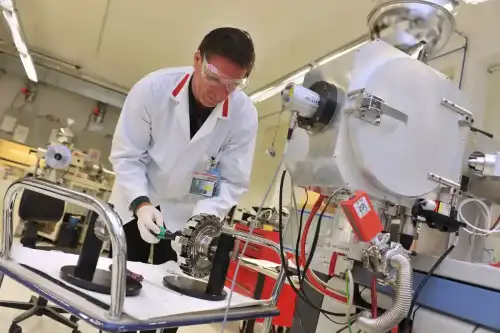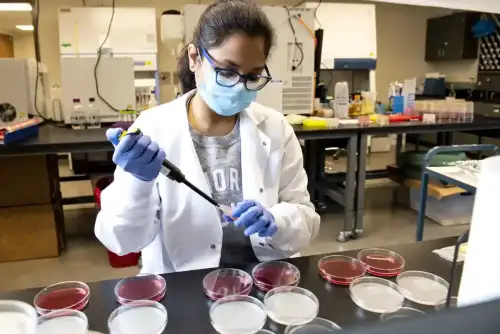Celiac.com 07/02/2025 - People with celiac disease or wheat allergy must avoid even tiny amounts of gluten, a group of proteins found in wheat, barley, and rye. Eating gluten triggers a strong immune reaction in people with celiac disease, damaging their intestines and leading to a range of symptoms from digestive problems to long-term nutrient deficiencies. To help protect these individuals, food labeled as “gluten-free” must contain less than 20 milligrams of gluten per kilogram of food.
Testing for gluten in food products is therefore essential. The most common method used today is a laboratory test called an enzyme-linked immunosorbent assay, which uses antibodies to detect specific parts of gluten proteins. However, these tests can sometimes give inconsistent or inaccurate results. They often focus on just one part of gluten—called gliadin—and may not account for other gluten components like glutenin. This inconsistency becomes a problem when trying to ensure safety across different types of food or when new gluten-free products enter the market.
Celiac.com Sponsor (A12):
A newer method known as mass spectrometry has the potential to improve the accuracy of gluten testing. This method works by detecting small fragments of proteins, called peptides, and can be much more specific than current techniques. However, to use it effectively, scientists need to find a way to convert the amount of peptide measured into the total amount of gluten protein present. That’s where this study comes in.
Developing a Better Gluten Detection Method
The researchers set out to solve a key challenge: how to turn the amount of gluten peptides measured by mass spectrometry into a reliable estimate of the total gluten protein in a food sample. To do this, they started by creating a set of well-defined protein samples from wheat flour using a classical process called Osborne fractionation. This process separates the different types of proteins in wheat, including gliadins and glutenins.
Once the protein fractions were isolated, they were analyzed using various laboratory methods to confirm their composition. This included examining how the proteins reacted with antibodies and testing them with blood samples from people who have IgE-mediated wheat allergies (a different type of immune reaction than celiac disease). These tests ensured that the protein fractions were clinically relevant and contained the types of gluten that cause real-world reactions in sensitive individuals.
Next, the team identified four promising peptide markers—small protein fragments that could be reliably detected using mass spectrometry. These markers were carefully selected from key parts of gluten proteins known to cause immune reactions in both celiac disease and wheat allergy. Two of the markers came from a type of gliadin protein, one came from a gamma-gliadin protein, and one from a low-molecular-weight glutenin protein. Some of these markers also overlapped with regions known to be toxic to people with celiac disease.
The selected peptides were then synthesized with a heavy isotope label, a special chemical tag that makes them easier to detect and measure accurately in mass spectrometry.
Establishing Conversion Factors: From Peptide to Protein
The next challenge was determining how to translate the amount of peptide detected into the amount of total gluten protein in a food sample. The researchers explored two approaches: one based on theoretical calculations and another based on experimental data. They compared how well each approach worked for converting peptide measurements into actual gluten protein amounts.
Experimental methods turned out to be more accurate. In particular, when they used protein fractions enriched for glutenin, they got results that closely matched those obtained using a completely different test known as the Dumas method (which measures total nitrogen in a sample to estimate protein content).
One of the peptides, named VQQIPVVQPSIL, showed excellent sensitivity, meaning it could detect very low levels of gluten in a sample—around 10 milligrams of gluten per kilogram of food. This is below the international threshold of 20 milligrams per kilogram for gluten-free labeling, making it suitable for real-world applications.
Real-World Relevance and Clinical Validation
To make sure the test would work in practical settings, the researchers applied it to real wheat flour samples. The results confirmed that the method could detect and quantify gluten effectively. They also validated the clinical relevance of the protein markers by showing that the gluten fractions reacted with blood from patients with wheat allergies.
Importantly, some markers used in this test include known toxic fragments that are responsible for triggering celiac disease. This makes the method particularly valuable, because it targets the components of gluten that matter most for people with gluten sensitivity or immune responses. It also offers a more complete picture by including peptides from both gliadin and glutenin proteins—unlike older tests that only focus on gliadin.
Why This Study Matters to People with Celiac Disease
This study is an important step forward in gluten detection. For people with celiac disease, even trace amounts of gluten can cause serious health problems. That means food manufacturers and regulators need the most accurate testing methods available to ensure safety and prevent accidental exposure.
The mass spectrometry-based method described in this research offers a promising alternative to current antibody-based tests. It provides more precise and consistent results and can detect parts of gluten that are known to trigger celiac disease. It also includes a clear way to convert the amount of peptide detected into an estimate of total gluten protein, making it suitable for regulatory use.
If this method is adopted more widely, it could improve the accuracy of gluten-free labeling and increase consumer confidence in the safety of gluten-free products. For those living with celiac disease, better testing means fewer health risks, less stress, and more freedom in choosing what to eat.
Final Thoughts
In summary, this study developed a new, highly sensitive method for measuring gluten in food using mass spectrometry. By selecting key peptide markers and creating accurate conversion factors, the researchers laid the groundwork for a more reliable gluten detection system. Their work could help food producers meet labeling requirements more accurately and help protect people with celiac disease from unintended gluten exposure. As gluten-free diets become more common and food options expand, this kind of scientific advancement becomes even more essential.
Read more at: pubs.acs.org










Recommended Comments
There are no comments to display.
Create an account or sign in to comment
You need to be a member in order to leave a comment
Create an account
Sign up for a new account in our community. It's easy!
Register a new accountSign in
Already have an account? Sign in here.
Sign In Now